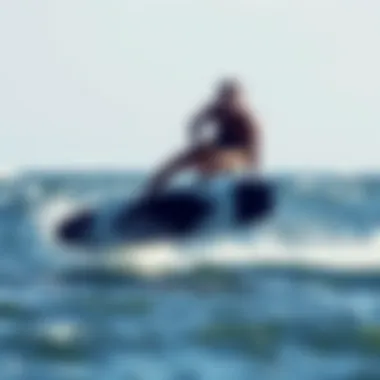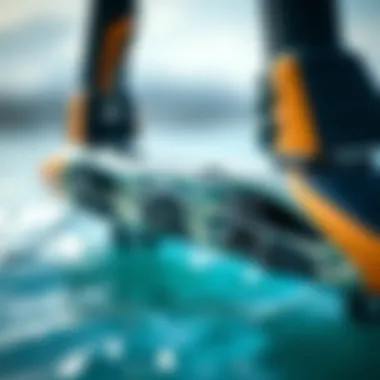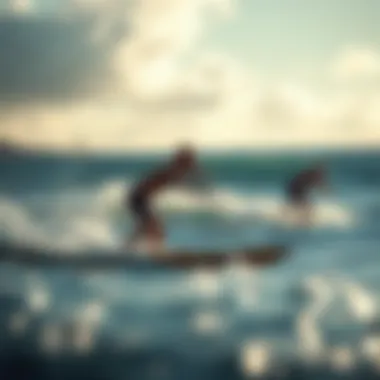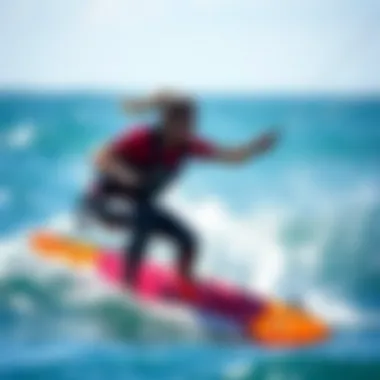Exploring Foiling Surfing: The Future of Water Sports


Intro
Foiling surfing is not just a passing trend; it represents a true evolution in the world of water sports. As more enthusiasts flock to the waves, this innovative style of surfing—a unique blend of hydrofoil technology and surfing technique—is carving out its niche’s very own. This sport allows riders to soar above water, utilizing a hydrofoil that lifts the board off the water's surface, enabling fluid motion and reduced drag. This article will walk you through the gear and equipment essential for foiling, the techniques that can elevate your skills, and critical safety practices to keep your experience enjoyable.
Understanding foiling surfing is more than just mastering the balance between board and water; it’s about integrating specialized equipment and honing techniques that cater to both beginners and experienced riders alike. You need to know the nuances that distinctively position foiling surfing apart from traditional surfing or kiteboarding. To that end, let’s kick off with the must-have gear that will aid you in your journey to enjoy this exhilarating water sport to the fullest.
Gear and Equipment
When it comes to foiling surfing, your gear is your lifeline. With the right equipment, you can maximize your fun while minimizing risks.
Essential Gear for Beginners
- Foil Board: Look for a short, wide board specifically designed for foiling; these boards help with stability.
- Hydrofoil: A hydrofoil consists of a mast and wing; beginners should opt for larger wings for better lift at lower speeds. Brands like Slingshot and Naish offer solid starter options.
- Safety Leash: Ensures you don’t lose your board in the water, especially when you are still figuring things out.
- Personal Flotation Device (PFD): Safety cannot be overstated. A well-fitted PFD will give you peace of mind as you master your skills.
- Wetsuit: Depending on your location's water temperature, a wetsuit keeps you insulated and protected from the elements.
Advanced Equipment for Experienced Riders
- Performance Foil: As you grow, you might want a stiffer and smaller wing for more agility and speed. A company like GoFoil provides options tailored for advanced users.
- Carbon Fiber Board: For those looking to shave off weight and improve performance, a carbon fiber board is a premium investment.
- Custom Leash Designs: Advanced riders may want to consider a quick-release system for ease in case of wipeouts.
Incorporating cutting-edge gear is crucial for safety and performance in foiling surfing. Always assess equipment compatibility with your skills before hitting the water.
Keeping yourself up to date with equipment advancements can make the difference between struggling and soaring through the waves. In the next section, we’ll dive deeper into the techniques and tips tailored to enhance your foiling experience on the water.
Prelims to Foiling Surfing
Foiling surfing represents something truly unique in the realm of water sports. At its core, the sport harnesses innovative technology—hydrofoils that lift boards above water, providing a sensation akin to flying over the waves. This revolutionary practice shifts the dynamics of riding water, making it vastly different from its traditional counterparts like surfing or kiteboarding.
The allure of foiling lies not just in its novelty, but also in the rich experiences it offers to participants. Riders quickly experience the thrill of gliding, as if riding on air while only being a few feet above the water's surface. With every swell, there’s a sense of empowerment and connection with nature that’s hard to put into words.
Benefits of Foiling
Foiling opens doors to new capabilities in the water. Unlike regular surfing, where conditions like wind and wave height dictate the experience, foiling can be enjoyed in a variety of environments, even in smaller, less powerful waves. This adaptability makes foiling appealing to a wider audience, from adventurous novices exploring a new horizon to seasoned pros looking to refine their skills.
Moreover, this sport is physically engaging; it challenges balance, focus, and coordination. Those who regularly practice foiling can develop core strength and improve their overall fitness. Engaging with the water in this unique way builds not only skills but also confidence, as riders learn to control their boards through various conditions, embracing both the struggle and the triumph of mastering a new hobby.
Considerations to Keep in Mind
While the idea of soaring above the sea may sound enticing, various factors should be taken into account before diving in. Understanding the equipment is crucial, as not all boards and foils are made the same. Riders must also consider their ability level; while some may feel drawn to the sport, they need to recognize the learning curve involved.
Environmental elements cannot be overlooked either. Riders should always respect nature and the bodies of water they choose to explore. Monitoring weather conditions, tides, and local wildlife not only enhances safety but fosters a deeper respect for ecosystems in which they engage.
Fundamental Principles of Foiling
Foiling surfing represents a significant shift in the realm of water sports, blending skill with an understanding of physics. Grasping the fundamental principles of foiling is crucial for anyone who wants to ride the waves and glide above the water's surface. This section dives into the essence of foiling, unraveling the layers of mechanics and science that make this sport both exhilarating and accessible.
Understanding Hydrofoils
At the heart of foiling surfing lies the hydrofoil. This ingenious piece of equipment, typically resembling an underwater wing, generates lift by channeling the flow of water beneath it. When a surfer gains enough speed, the hydrofoil rises out of the water, allowing for a smooth ride above the surface. This lift is derived from the pressure differences created by the shape of the foil. Lift occurs when water moves faster over the top surface than it does underneath. Essentially, the hydrofoil allows surfers to ride with reduced drag, ultimately leading to greater speed and performance.
The choice of hydrofoil can dramatically impact a surfer’s experience. Different designs cater to various conditions. A broader foil helps in slower waters while narrower foils are ideal for speed. Importantly, knowing how to select the right hydrofoil based on personal skill level and the conditions can make or break a session on the water.
Aerodynamics and Hydrodynamics Explained
Diving deeper, the concepts of aerodynamics and hydrodynamics are foundational to understanding how foiling works. Aerodynamics deals with how air interacts with solid objects; in foiling, it's about how the shape of the board influences air flow as the surfer gains momentum. Conversely, hydrodynamics relates to how water behaves around the foils. These scientific principles intertwine to dictate performance.
- When the hydrofoil cuts through the water, the angle at which it meets the surface is critical. The lift generated is not only a factor of speed but also the angle of attack. Too steep, and the foil may stall; too shallow, and it won’t lift at all.
- It’s also essential to consider the water conditions—currents and waves play a significant role. A skilled surfer adapts their technique to harmonize with these elements, maximizing the potential lift their foil can provide.
Challenges like these can often be a steep learning curve. Yet, mastering the interplay of aerodynamics and hydrodynamics can elevate one’s experience and enjoyment in the sport. For those keen-eyed kiteboarders or adventure seekers out there, understanding these principles is key to evolving your skills and pushing your limits.
“The excitement of foiling surfing lies in its marriage of art and science—each rider must become a student of nature, learning the nuances of both wind and water.”
With that foundation laid, newcomers and veterans alike can appreciate the intricate dance between the surfer, the hydrofoil, and the elements. Knowing how these fundamental principles interact paves the way for exciting discoveries on the water.
Equipment Overview


Understanding the right equipment is crucial in foiling surfing, as it can significantly affect both your performance and experience on the water. Choosing the correct setup not only enhances your ability to ride but also ensures that you have a safe and enjoyable time. From boards to foils, each component plays a vital role in how you interact with the water and the waves.
When you step onto a foil board, you're stepping into a realm that combines innovation, physics, and a dash of adrenaline. It's the synergy between the rider and the equipment that opens up a world of possibilities. The right gear can elevate your ride, enabling you to glide smoothly over the surface, dance with the waves, and even soar into the air with aerial maneuvers.
Selection of Foil Boards
The first piece of equipment that one must consider is the foil board itself. Selecting a foil board involves understanding its dimensions, shape, and design, which all contribute to its performance on the water. Boards are generally categorized into three main types: shortboards, longboards, and cruising boards. Selecting the right one hinges on your skill level and the type of riding you aspire to do.
- Shortboards are designed for dynamic maneuvers and quicker turns, catering primarily to experienced riders who wish to perform tricks.
- Longboards typically offer more stability, making them more suited for beginners or those who prefer a smoother ride.
- Cruising boards are a hybrid, providing a balance of performance and ease, ideal for those who want to enjoy long rides without the emphasis on tricks.
When selecting a foil board, also take into account the weight capacity and the type of foiling conditions you expect to encounter. Boards can vary significantly, so a well-informed choice can lead to a more fulfilling foiling experience.
Types of Foils: What You Need to Know
The foil itself is arguably the engine of the whole operation. In foiling, there are different types of foils, and understanding their distinct characteristics can mean the difference between a smooth ride and a challenging outing.
- High Aspect Ratio Foils are designed for speed. They provide less drag and excel in flat water conditions, making them a favorite among those looking to cover long distances quickly.
- Low Aspect Ratio Foils tend to provide better lift at lower speeds. They're generally better suited for riders looking to perform tricks or those who are just starting out.
- All-rounder Foils bridge the gap between the two, offering a balanced experience suitable for various types of riding.
Moreover, the material and construction of the foil significantly influence performance. Many modern foils utilize lightweight materials that help improve maneuverability while still providing strength and durability.
Safety Gear Essentials
In any water sport, safety isn't just a checklist item; it's a necessity. Because foiling surfing introduces a level of height and speed, the importance of appropriate safety gear cannot be overstated. Here are some essential pieces to consider:
- Helmets: Protecting your head from unexpected falls or collisions is key. Choose one specifically designed for water sports for maximum comfort and safety.
- Impact Vests: These provide extra buoyancy and protect your torso during falls.
- Wetsuits: Especially crucial in colder waters, a wetsuit helps maintain body temperature and provides some impact protection.
Additionally, consider investing in a leash. A good leash will keep your foil board close during wipeouts, ensuring it doesn't float away or become a hazard to other riders.
In summary, investing time into understanding your equipment is a step towards mastering the art of foiling surfing. Each component plays a crucial role in boosting your skills and confidence on the water. The world of foiling surfing is exhilarating, but ensuring you’re properly equipped lays the groundwork for an enjoyable experience.
Learning the Basics
Foiling surfing is not just about the thrill of cutting through water atop a board; it's a dance with the element of water that demands skill, precision, and understanding. Mastering the basics is essential for anyone looking to truly excel in this sport. If there’s one piece of advice that can be echoed by seasoned foilers, it’s that the foundation you build today dictates your performance tomorrow.
Understanding the nuances of initial setup, balancing, and starting from water makes the difference between a frustrating session and exhilarating enjoyment. In this section, we'll delve into these fundamental aspects, ensuring that you have the tools needed for a smooth ride on the waves.
Initial Setup Techniques
Setting up your gear properly is the first step to a successful foiling experience. Imagine trying to perform an aerial maneuver but struggling because your equipment isn’t aligned correctly. Here’s how to set yourself up for success.
- Wings and Board Alignment: Ensure your hydrofoil wings are attached firmly to the board. Verify angles and positions, as even a slight misalignment can alter your ride.
- Foot Placement: Position your feet over the center of the board. This balance helps in controlling your movements and enhances stability.
- Harness Adjustment: If you're using a harness, it should fit snugly but allow for movement. A poorly adjusted harness can restrict your range of motion,
affecting your ability to maneuver and balance.
Making adjustments prior to hitting the water can streamline your experience and allow you to focus more on executing maneuvers instead of wrestling with gear.
Balancing on a Foil Board
Balance is the bedrock of foiling surfing. If you can find your center of gravity while riding, you'll be soaring above the waves in no time. This entails not just physical balance but mental acuity as well. Here are some essential tips to help master balancing:
- Knees Slightly Bent: Keep your knees flexed to act as shock absorbers. This flexibility helps you react to the shifting water and aids in staying stable.
- Upper Body Position: Your torso should remain straight but relaxed. Lean slightly forward when gaining speed and shift your weight back when slowing down.
- Eyes on the Horizon: Focus on a point in the distance rather than the water directly in front of you. This perspective aids in maintaining balance and stability.
Practice makes perfect, but remember, it starts from a calm place. If you feel jittery, take a moment to breathe and adjust before tackling waves.
Starting from the Water: A Guide
Getting out of the water on your foil board might seem daunting, but with the right mindset and technique, it can be as smooth as a leisurely stroll. Here's how to do it effectively:
- Position Yourself Appropriately: Lay face down on your board with the foil pointing towards the shore. Ensure your arms are extended and your feet are hanging over the edge, ready to kick off.
- Paddling Out: Use synchronized strokes to paddle away from the beach. Focus on creating a streamlined posture to make paddling easier. Your body should act as a guide to slice through the water.
- Engaging the Foil: Once you find your space, transition from paddling to standing as swiftly as possible. Use your core strength to give yourself a boost and maintain your balance as you rise.
The way you start from the water can affect your entire session. Proper techniques not only minimize struggle but also amplify enjoyment. This sport is as much about flow as it is about effort.
Learning the basics paves the way for advanced maneuvers later on. Each of these elements intertwines to create a cohesive experience in foiling surfing. With patience and practice, the water will become a canvas, and your foil board, the brush you wield to paint your adventures.
Advanced Techniques
Engaging in foiling surfing isn't just about gliding atop the waves; it's a craft that demands mastery of advanced techniques. The significance of refining these skills cannot be overstated, as they can elevate a novice rider into the realm of seasoned pros. Beyond just fun, these techniques can enhance control, ensure safer riding, and increase overall enjoyment of the sport.


When one thinks about mastering foiling, carving and turning mechanics, jumping and aerial maneuvers, as well as riding swell and waves effectively are pivotal areas to focus on. Getting these elements right is essential, not only for performance but also for the seamless connection between the rider and the dynamics of the water. Let’s break down these techniques further.
Carving and Turning Mechanics
Carving is a fundamental technique in foiling surfing that allows riders to change direction gracefully and with purpose. Unlike traditional surfing, the foiling setup introduces different dynamics due to its buoyancy. A proper carve requires not only balance but also an understanding of how to shift weight effectively.
- Weight Distribution: Your foot positioning plays a crucial role in how well your turns are executed. Focus on applying pressure to the front foot while shifting your hips and shoulders in the direction of the turn.
- Edge Control: Engage the foil's edges to grip the water while making turns. Precision here improves maneuverability immensely.
- Angle of Attack: Each turn involves adjusting the angle at which the foil meets the water. Too steep an angle can lead to a stall, while too shallow a cut may cause loss of speed.
Mastering these small details can set you apart in the foiling community, leading to more creativity in styling and tricks.
Jumping and Aerial Maneuvers
Jumping on a foil is an exhilarating part of the sport, yet it demands significant technique and timing. Aackward, unexpected movements can sabotage an aerial attempt quickly. To execute jumps successfully, here’s a foundation to build on:
- Pop Off the Water: Start with a solid foundation by bending your knees and using your legs to spring off the water. Timing is essential; the moment you feel the lift from the foil is the point to push off.
- Keep Your Eyes Up: Look ahead during the jump, keeping your focus on the landing area. This not only improves balancing upon descent but also eases the overall landing process.
- Control Your Descent: As you come back down, gently bend your knees to absorb impact. Maintaining a lively stance can help you sink back into the water without crashing.
Riding Swell and Waves Effectively
Navigating swell and waves presents unique challenges and offers thrilling experiences. Understanding how to ride these natural formations can vastly improve performance and control. Here are some things to consider:
- Reading Swell Patterns: Successful foiling requires developing a keen ability to interpret and predict wave movements. Pay attention to the conditions before you hit the water; their subtle shifts can dictate your riding experience.
- Angle of Attack: When riding, holding the right angle against the wave is crucial, as it determines how well the foil lifts. A steeper angle can create more lift, but balance it out to avoid flipping.
- Maintain momentum: Rolling with the swell means staying in rhythm. Paddling early or maintaining speed will allow you to catch waves efficiently, enhancing your overall effectiveness.
Mastering these advanced techniques can mean the difference between an average session and a thrilling one. Incorporating carving, jumping, and mastering the swell not only develops your skills but also deepens your enjoyment and engagement with foiling surfing. As you progress, these nuances transform from learning hurdles into markers of proficiency.
"Technique is the backbone of skill. Understand them, and they will elevate your foiling experience to greater heights."
Exploring alternative resources, such as Wikipedia on Hydrofoils or forums on Reddit related to print materials can further aid in expanding your foiling knowledge.
Safety Considerations
When it comes to foiling surfing, safety isn't simply an afterthought; it's a fundamental part of the experience. As thrilling as it may be to glide above the surface of the water, numerous risks are associated with the sport, and understanding them can make the difference between a nasty spill and a day of adrenaline-fueled fun. In this section, we will dive deep into the essential safety considerations, dissecting the environmental factors and the personal safety equipment that every foiler should have.
Understanding Environmental Factors
Before hitting the waves, it’s crucial to keep an eye on the conditions of the water and surrounding environment. Various factors can impact your safety:
- Wind Conditions: Wind not only affects your ability to maneuver on a foil but can also lead to unexpected hoisting or drifting away from your intended spot. A sudden gust can make things precarious.
- Water Currents: Currents can be unpredictable. Familiarize yourself with local tides and currents to avoid ending up downstream or in dangerous zones. Ignoring this can lead you to trouble, especially for less experienced surfers.
- Wave Conditions: Strong waves can be exhilarating but also hazardous. Always be sure to assess wave height and power before heading out, as bigger swells call for advanced skills. On an experienced day, you may want to reconsider whether it’s safer to stay on land.
- Surrounding Wildlife: Keep an eye out for local aquatic life, such as jellyfish or sharks, especially in warm waters. Understanding the wildlife in your area can be the difference between a close call and an otherwise enjoyable session on the water.
Being cognizant of these environmental variables can help ensure a safer and more pleasurable experience.
Personal Safety Equipment
Equipping yourself with the right personal safety gear is absolutely non-negotiable in foiling.
- Helmet: A good quality helmet can protect your head from impacts. It’s wise to invest in a well-fitting one, as your balance might be off after a wipeout.
- Impact Vest: This lightweight vest can absorb shocks from falls, which are common for beginner foilers. It can make crashes a lot more manageable, saving you from long-lasting soreness.
- Leash: Similar to what you would use for traditional surfing, a leash keeps your board close after a fall. Losing your board can lead to unnecessary risks, including injuries from a drifting board.
- Wetsuit: In colder waters, a wetsuit helps you maintain body heat and protects against scrapes from the board or surf. They can be a lifesaver, especially during extended sessions.
- PFD (Personal Flotation Device): Though foiling generally stays above the surface, having a PFD is a smart move, especially in more turbulent waters.
It's clear that the right gear not only enhances your comfort but also significantly mitigates risks associated with foiling surfing. Always remember that taking precautions is crucial in enjoying the sport to its fullest without the stress of injury or mishaps.
"Safety is not just a priority; it's the foundation from which you can explore, learn, and enjoy foiling surfing to the max!"
With these considerations in mind, you're better prepared to tackle the waves while enjoying the thrill that foiling has to offer.
The Evolution of Foiling
Foiling surfing stands at the crossroads of tradition and innovation, embodying a transformative journey traversed over several decades. Understanding the evolution of foiling not only enriches one’s appreciation for this exhilarating sport but also highlights its trajectory within the broader realm of water sports. The importance of recognizing how foiling has developed through time lies in the various advancements that have shaped its current form and the community that surrounds it. From historical roots to cutting-edge designs, the evolution of foiling reveals much about human ingenuity and the endless pursuit of progress on the water.
Historical Context of Foiling Sports
The roots of foiling can be traced back to the late 19th century when sailing enthusiasts began experimenting with hydrofoil technology, aiming to increase efficiency and speed on the water. Early prototypes were rudimentary, relying on fixed wings submerged below the water's surface. It wasn’t until the 1960s that the concept took off, literally and figuratively. The introduction of the first hydrofoil sailboats stirred curiosity among sailors and engineers alike. Key figures, such as inventor and aviation pioneer Antonio de la Cierva, were instrumental in propelling these concepts into practical applications.


In the surf world, foiling made its waves in the late 90s when the technology was applied to surfboards and later, stand-up paddleboards. This transition from boats to boards unveiled a new dynamic for wave riding. Enthusiasts began to understand that with foils, they could ride above the water's surface, allowing for smoother rides and the capability to glide over choppy waters.
"The history of foiling is as much about pushing boundaries as it is about embracing the elements."
Today, foiling’s rich history has become a crucial lesson for modern riders, teaching them the importance of innovation and adaptability in sports.
Key Innovations in Foiling Technology
Just as a wave can change with the wind, so too has the technology surrounding foiling evolved. Key innovations have played a significant role in enhancing performance and accessibility. Consider the following advancements:
- Material Science: The development of lightweight materials such as carbon fiber has greatly improved the construction of foils, making them easier to handle and allowing for better responsiveness. These materials have revolutionized how riders experience foiling, enabling them to tackle waves and swells with unprecedented dynamism.
- Wing Design: Modern designs have further refined wing shapes for optimal lift and speed. Engineers have introduced variations in aspects like camber, aspect ratio, and surface area, each tailored to different conditions and rider preferences. These improvements facilitate smoother take-offs and landings, making the sport more accessible to newcomers.
- Control Systems: The integration of smart technology, such as remote control systems and adjustable foils, gives riders enhanced control. This allows for real-time tuning of foil settings depending on wave conditions, offering a tailored experience while promoting skill development.
With these innovations, foiling has not just advanced in terms of performance but has also attracted a diverse range of participants, from casual beach-goers to competitive athletes.
As foiling surfing continues to evolve, one can only imagine what future inventions will shape the experience for those riding the waves. The thrill of gliding above the surface remains a testament to the creativity and dedication driving the sport forward, reflecting a culture that thrives on exploration and challenge.
Foiling Communities and Culture
Foiling surfing isn't just about gliding over the water and catching air; it’s also about the communities that thrive around the sport. These groups form an essential tapestry, weaving together enthusiasts of all skill levels. Understanding these communities can elevate your foiling experience tremendously.
Communities, whether local or global, play a pivotal role in sharing knowledge, safety practices, and the sentiments that bind people around this exciting sport. More than just a performance measure, these social interactions help transcend the barriers of age, background, and skill level. Here’s a closer look at the segments that make up the foiling community.
Local and Global Foiling Networks
Local foiling networks are like wildfires, sparking enthusiasm wherever they land. Clubs and formal associations often offer a sense of belonging, providing resources and camaraderie to new and seasoned foilers alike. In smaller towns or major coastal cities, these local groups engage in meetups where tips and tricks can be shared over a pizza or a sunset.
You’ll often find boards laid out along beaches while friends dive deep into discussions about the latest gear, sharing insights on what worked for them in the water.
On the broader scale, global foiling networks leverage platforms such as websites and forums. Places like Reddit or organized Facebook groups host a wealth of information. On these platforms, discussions span the globe, connecting foilers from different backgrounds, nations, and skill sets. Experiences, gear reviews, and safety tips flow freely through these channels. People from Hawaii to Australia to Portugal can find common ground, further enriching the sport.
Events and Competitions
Events and competitions within the foiling surfing community signal the thrill and challenge of the sport. They are not only platforms for showcasing talent, but also gatherings for learning and improvement. Here’s why events matter:
- Showcase Skills: Competitions give riders a chance to test their skills against others while inspiring others to push their limits.
- Community Building: They foster a strong sense of community, as foilers come together, encouraging each other and celebrating successes.
- Learning Opportunities: Many events offer workshops, clinics, and coaching, creating a space for newcomers to learn sat from the experienced experts. Everyone shares their success and failures leading to growth.
- Promotion of the Sport: High-profile events attract media attention, helping raise awareness and grow participation in foiling surfing, drawing in newcomers like moths to a flame.
Upcoming events can often be found on platforms such as the International Windsurfing Association’s site or athletes’ personal social media pages.
To sum up, the foiling community is thriving, powered by local connections and global networks. These groups enhance the foiling experience, making every ride more than just a solo endeavor on the ocean; they transform it into a shared journey filled with learning, support, and celebration. In a world that often feels divided, foiling brings together those seeking thrills and a sense of belonging on the waves.
The Future of Foiling Surfing
Foiling surfing has emerged as a vibrant and dynamic facet of water sports, captivating adventurers and enthusiasts alike. As this sport skyrockets in popularity, its future seems to be teeming with potential developments and trends that could reshape not only the activity itself but also how communities interact with it. The exploration of emerging trends and the technology powering this sport can offer invaluable insights to both newcomers and seasoned practitioners.
The prospect of foiling surfing isn’t just about catching waves; it’s a holistic transformation affecting techniques, accessibility, and even environmental sustainability. As we look ahead, it’s crucial to recognize the importance of staying informed about what’s on the horizon in this exhilarating sport. The innovations and trends will elevate experiences, expand communities, and even attract a broader audience to the world of foiling.
"The adaptability of foiling techniques and advancements in equipment will play a pivotal role in bringing this sport into the mainstream."
Emerging Trends in Foiling
The landscape of foiling surfing is evolving, and several trends have started to carve a niche in this adventurous world. One of the most notable trends is the increased interest in electric hydrofoils. These electric foils allow surfers to glide above the water without relying solely on waves and wind. With battery technology improving, these boards can run longer, allowing enthusiasts to adventure further into the water without worrying much about wind conditions or wave size.
Additionally, there's a growing emphasis on community-driven events. Local groups are organizing more meet-ups, competitions, and clinics, creating a vibrant social fabric around foiling surfing. Such initiatives foster an sense of camaraderie among surfers, from fresh faces learning the ropes to veterans sharing their wisdom.
Other trends to consider include:
- Eco-conscious materials: Manufacturers are now exploring sustainable materials for boards and foils, aiming to reduce their carbon footprints.
- Increased accessibility: Rental services for foiling gear are popping up in more regions, making it easier for people to try foiling without immediate hefty investments.
- Cross-discipline growth: Foiling is not limited to surfing. Kiteboarding and windsurfing are adapting foiling methods, creating hybrid experiences that attract participants from various water sport backgrounds.
Potential Developments in Equipment Technology
When we look to the future of foiling surfing, it’s evident that advancements in equipment technology will play a major role. Manufacturers are in a veritable arms race to create the lightest and most durable materials. Current foils might be made of carbon fiber and other lightweight composites. The quest for materials that can withstand the elements while allowing for enhanced performance will likely spur innovations.
Moreover, smart technology integration may soon become commonplace in foiling boards. Imagine boards equipped with sensors that provide real-time data on speed, balance, and environmental conditions. Such technology would not only enhance safety but could also deliver a more tailored experience for every surfer.
Moreover, personalizing foils is on the rise—the option to customize board shapes, sizes, and even color schemes is becoming more mainstream. This trend not only reflects individual styles but also caters to specific performance needs. It enables surfers to truly make their boards an extension of themselves.
In summation, as foiling continues to carve its niche in the water sports scene, keeping an eye on these emerging trends and technological advancements can greatly benefit participants at all skill levels. The future of foiling surfing appears bright, promising richer, safer, and more sustainable experiences for those adventurous enough to ride the next wave.



